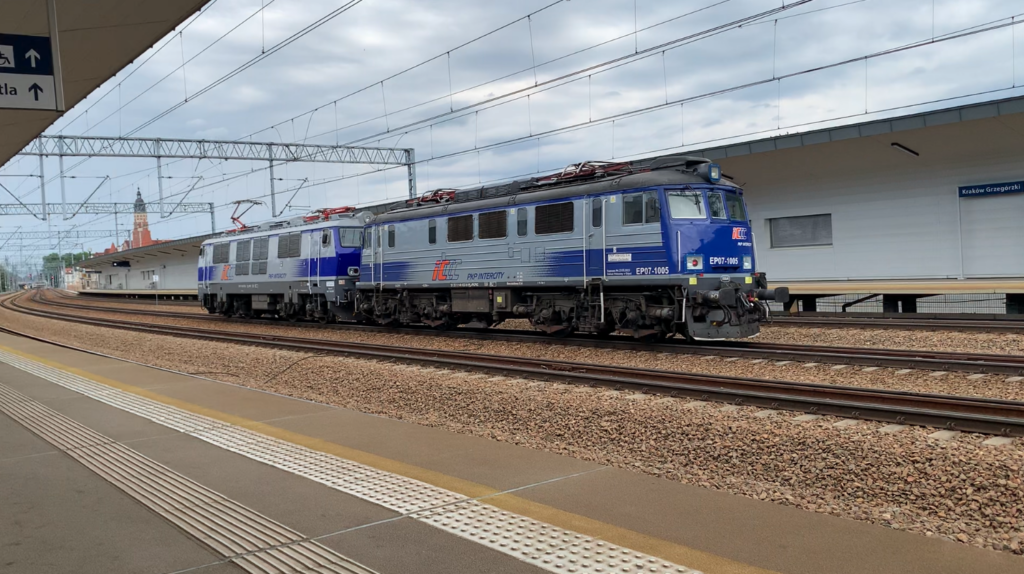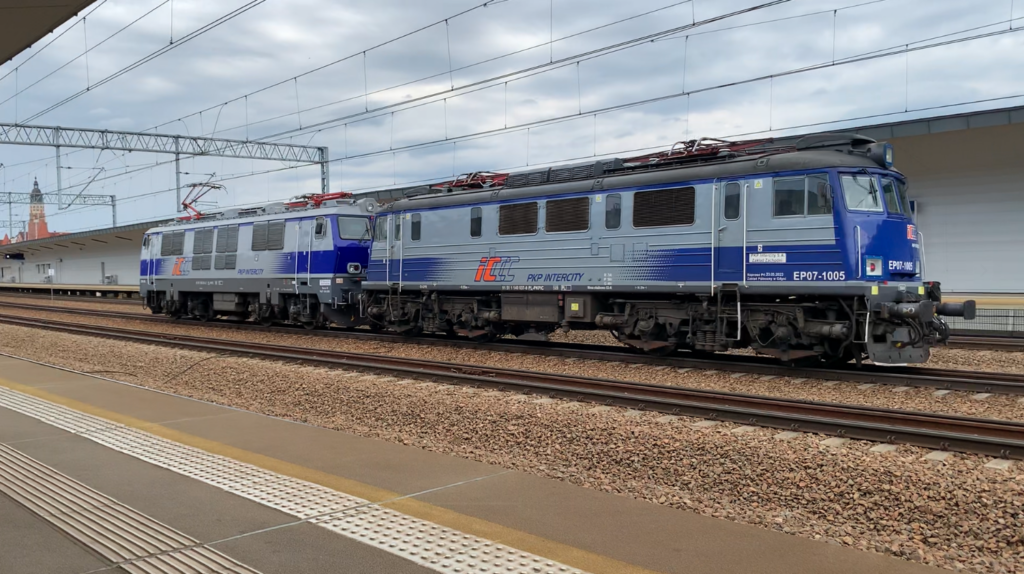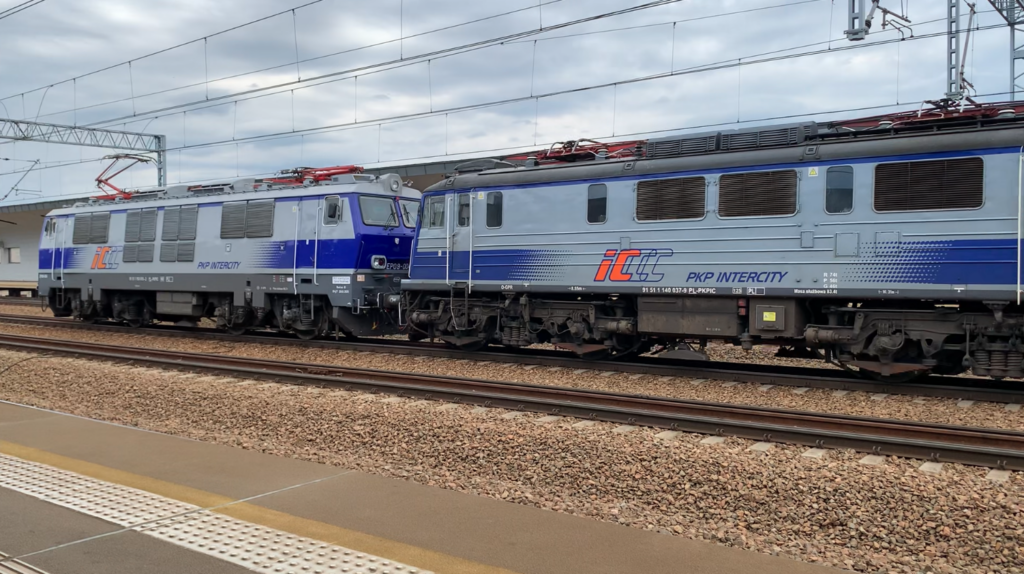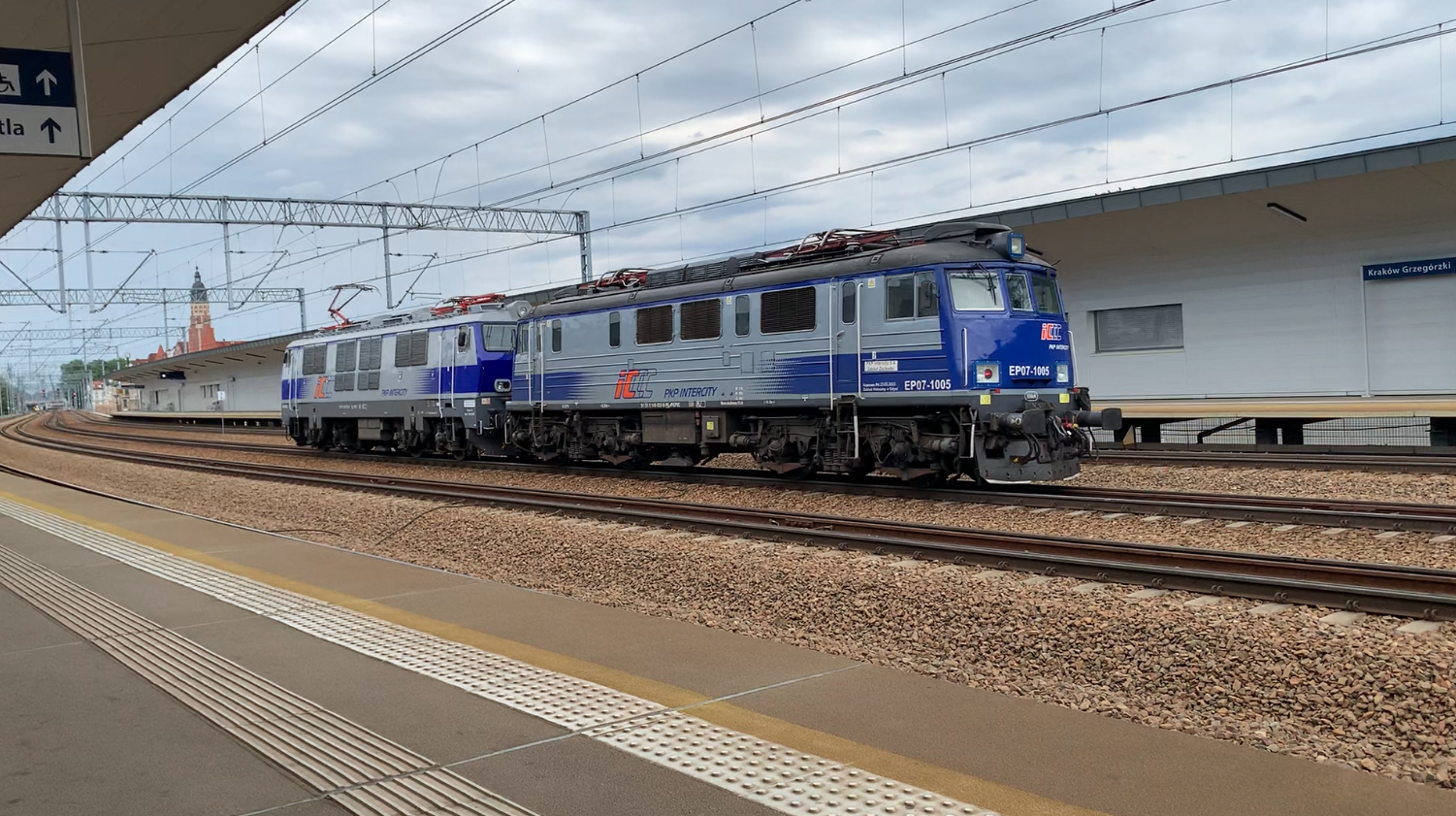Kraków 2025-10-11
Electric Locomotive EP07-1005.



History.
By the end of the 1950s, electrification on Polish railways was progressing rapidly. Electric locomotives were needed for passenger and freight trains. First, Swedish locomotives were purchased, designated EP03 in Poland. The locomotive was manufactured by Allmann Svenska Elektriska Aktiebolaget and was designated ASEA E150. In 1951, eight locomotives were purchased for the Polish State Railways (PKP). Initially, the locomotives were assigned numbers in the E150 series. In 1951, the series designation was changed to E03, and in 1959, finally to EP03. An example of the EP03-01 locomotive is located in the Railway Open-Air Museum in Chabówka.
A Polish locomotive, the PaFaWag 1E, was also developed, which was designated E02 and eventually EP02 by the Polish State Railways (PKP). Between 1953 and 1957, eight 1E locomotives were built, numbered E110 to E117. The locomotives were built at the State Wagon Factory in Wrocław. However, the EP02 locomotive was not very successful. Its running gear was poor and wore out quickly at higher train speeds. Therefore, after a few years, the train’s speed was limited to 70 km/h. The locomotive’s electrical system was sound, having come from English Electric. These were English designs and components, later replaced with Polish ones. The experience gained from operating the EP02 served to develop the ET21 type E3 electric locomotive. An example of the EP02 locomotive can be seen at the Railway Open-Air Museum in Chabówka.
Then, locomotives were purchased from the German Democratic Republic, designated EU04 in Poland. The factory designation was LEW E04. Initially, the Polish State Railways (PKP) assigned them the type designation E200, then E04, and finally EU04. These locomotives were built for PKP between 1954 and 1955 by the LEW Hennigsdorf plant in Hennigsdorf, East Germany. However, these locomotives were unreliable. According to other sources, the locomotives were good, but the German factory was unable to fulfill a large order for Poland.
In 1961, PKP (Polish State Railways) purchased 30 Škoda 44E Series 30 electric locomotives from Czechoslovakia, designated EU05 in Poland. The locomotives were built at the Škoda plant in Pilsen. They were good vehicles.
EU06 locomotive.
The search for a manufacturer of more successful locomotives continued. With considerable difficulty, the British company English Electric was accepted. This company had the world’s most experience in producing this type of vehicle. The locomotive chosen in Poland was designated EU06, Series 20. The EU06 locomotive was based on the English Electric Class 83 locomotive. Twenty units were purchased, along with a license to produce these locomotives in Poland. The EU06 locomotives were built in England between 1961 and 1962 at the Vulcan Foundry in Newton-le-Willows, Lancashire, England. In December 1961, representatives of the Polish State Railways (PKP) conducted the technical acceptance of the first locomotive. In the spring of 1962, the first EU06 locomotive was accepted for service at the Kraków Prokocim locomotive depot. Nineteen locomotives were delivered to Poland by the end of 1962, and the last was handed over in 1965, having undergone modernization work.
The then-state-of-the-art electric locomotive for PKP was built at the oldest locomotive factory in the world. The Vulcan Foundry was founded in 1825 by Robert Stephenson, son of George Stephenson, the famous steam locomotive designer. The EU06 locomotive could pull a 650-ton passenger train at 125 km/h or a 2,000-ton freight train at 70 km/h. The locomotive’s power output was 2,000 kW. Locomotives of this series could also operate two at a time in multiple shunting, allowing the train weight to be increased accordingly, up to 3,600 tons.
In accordance with Polish wishes, the EU06 locomotives received rectangular buffers. Three headlights, nicknamed “Buckets” in Poland due to their size, were mounted in the front wall of the locomotive. Additionally, the lower headlights were internally equipped with red tail lights. The front wall features three windows. The exterior windows were equipped with windshield wipers, the mechanisms of which were mounted above the windows. Multiple control sockets were centrally located on the front wall. Each driver’s cab had two entrances, one on the left and one on the right, unlike the later EU07. The locomotive received four rearview mirrors. The engine compartment had three windows and four ventilation grilles in each wall.
The locomotives were painted in the then-standard paint scheme: light green and dark green. The chassis was painted black. The pantographs were red. The main beam was painted red. Operating and information signs were painted white. Warning inscriptions and signs are displayed on yellow stickers. Decorative aluminum strips are placed on the locomotive body, covering the joints between the sheet metal. PKP (Polish State Railways) numbers are placed on the locomotive’s fronts and sides.
EU07, 4E PaFaWag locomotive.
In Poland, licensed production was outsourced to the PaFaWag factory in Wrocław. The English documentation had to be converted to Polish documentation by converting the English dimensions to the SI system. This required rounding some values. At the factory, the locomotive received the factory designation 4E, while at PKP it was designated EU07. Locomotive production began in 1963 and continued until 1974. According to other sources, production lasted from 1965 to 1977. In 1977, the assembly line was switched to the production of ET22 electric locomotives. Over the course of 11 years, 240 EU07 locomotives were built, despite the planned production of 300. The number of EU07 locomotives built has satisfied the most critical needs for passenger, express, and fast trains in Poland on electrified lines.
After service, the first EU07-001 was transferred to the Railway Open-Air Museum in Chabówka. The locomotive is in its original livery.
In 1976–1977, four EP08 series locomotives (serial numbers EP08-002 to 005; type 4Ea) were incorporated into the EU07 series because they did not meet the requirements of the EP08 series. They were equipped with a slide bearing, which proved unsuitable for the intended operating speed of the EP08. These locomotives were given new numbers EU07-241 to 244. EP08 (4Ea) locomotives were built from 1972, specifically for fast and express trains to and from Warsaw. These locomotives were nicknamed “Piggy” due to their orange color.
There are several differences between the “Englishman” EU06 and the EU-07. The locomotive’s entrance door layout was changed. Looking in the direction of travel, the right-hand door was moved rearward and located in the engine room. The same applies to the other end of the locomotive. This gave the engine room an additional window, which is located in the door. The side window at the driver’s station was widened. The Polish EU07 locomotive has a rain gutter that runs the entire length of the locomotive’s roof. In the EU06, gutters are located only in the driver’s cab area. The interior heating of the driver’s cabs is provided by 3000 V current, while in the “Anglik” locomotive, it is provided by 110 V current.
Locomotive EU07, 303E. HCP.
In 1983, production of EU07 locomotives resumed, this time at the HCP plant in Poznań. The Pafawag plant in Wrocław continued to produce the successful ET22 locomotives. At the same time, the production of ET41 locomotives at HCP in Poznań was discontinued.
The new EU07, type 303E locomotive was developed based on the two-section ET41, type 203E locomotive, which was derived from the type 4E locomotive. Production of the EU07, type 303E locomotives ran from 1983 to 1993. A total of 243 EU07, type 303E locomotives were built, receiving numbers 301-543. Locomotives with numbers 245-300 are no longer in production.
The new EU07, type 303E, features numerous modifications that increased its service life and reduced its failure rate. The number of points requiring frequent lubrication was reduced. Metal-rubber joints were introduced, improving the locomotive’s running comfort. The body structure was modified, and a self-supporting body with grooved side walls was used. These grooved walls are a distinguishing feature between the 4E and 303E locomotives. One ventilation grille, the first on the left side, looking in the direction of travel, was removed from the side wall of the engine compartment. A solid flat plate between the windows was left there, which began to be grooved halfway through production. Larger blades (scrapers) were also installed under the headstock. The new locomotives were adapted to accommodate the Soviet automatic coupler.
In the EU07 model, type 303E, several outdated features were retained. Resistance starting was still used. Electronic control was not implemented. This was a result of the crisis in the national economy, which could not afford new technologies. The Polish economy was poorly managed by the communists.
In the period 1990–1994, three sections of the ET41 electric locomotives were also converted to EU07 locomotives, type 303E. They were equipped with an additional cab. The locomotives were given numbers EU07-537, EU07-544 and EU07-545.
EU07 designation (4E, 303E).
The term EU07 used by PKP denotes a universal electric locomotive designed to haul passenger trains weighing up to 700 tons at a speed of 125 km/h or freight trains weighing up to 2,000 tons at a speed of 70 km/h. The EU07 locomotive is built in a classic layout, with driver’s and assistant’s cabs at each end. It has two pantographs (current collectors). The traction supply voltage is 3,000 V. The axle configuration is Bo’Bo’. The locomotive is powered by four EE541A electric motors with a rated voltage of 1,500 V. Each motor is located on a single axle. The permissible operating temperature of the motor is 180°C, so the motors are cooled by a dedicated compressed air system. Multiple control sockets are located on the front ends of the locomotive, allowing for the operation of two coupled locomotives of the same type (a 4E with a 4E and a 303E with a 303E) by controlling both locomotives from the first cab. The exception are EU07 locomotives from numbers 241 to 244, which can only be coupled with an EP08. These are type 4Ea locomotives (EP08 no. 002-005) equipped with a slide bearing. This proved unsuitable for the intended operating speed of the EP08, and was therefore renamed EU07.
Differences between the type 4E and 303E:
The timing gear is changed, so only the same locomotive types can operate in multiple traction. The type 303E has a grooved, self-supporting body. The Type 4E weighs 80,000 kg, and the Type 303E weighs 83,400 kg. The Type 4E is 15,920 mm long, and the Type 303E is 16,310 mm long. The Type 303E can have a Soviet coupler installed and the buffers (buffers) removed. Different blades are also fitted under the front end.
EP07 Locomotive.
The EP07 electric passenger locomotive (Factory Types: 4E, 303E, and 303E-FPS, Fabryka Pojazdów Szynowych) is a series of standard-gauge electric passenger locomotives. These are rebuilt EU07 locomotives. The rebuilts were carried out between 1995 and 2008 by various ZNTK plants. Modernizations were carried out by, among others, ZNTK Oleśnica, ZNTK Mińsk Mazowiecki, HCP Poznań, and NEWAG Nowy Sącz. Initially, only the 303E locomotives (Poznań) were planned to be modernized, but the 4E locomotives (Wrocław) were also rebuilt.
The locomotive designated EP07 by PKP is a converted EU07 locomotive, adapted for passenger trains traveling at 125 km/h, the same speed as the EU07, but more easily maintained. In the EP07 designation, the letter “P” stands for passenger. As recently as the 1980s, the letter “P” was translated as an express passenger train. Conversions to EP07 locomotives were carried out at ZNTK from 1995. The designation was changed from EU07 to EP07, but the serial number remained the same. Between 2005 and 2008, 69 EP07 locomotives were built, assigned new numbers from 1001 to 1069.
The main change involved replacing the EE541 electric motors with LKB535 motors. The gear train between the motor and the locomotive’s wheels was also modified. The gear ratio is now 76:21, up from 79:18 previously. The LKB535 engines give the locomotive greater speed at lower RPMs. However, the EP07 locomotive is now unsuitable for freight trains due to its difficult starting. Multiple traction has been eliminated, and air conditioning has been installed.
Locomotive EP07-1005.
The EP07-1005 locomotive has the EVN number: 91 51 1 140 037-9 (PL-PKPIC). The locomotive was manufactured in 1985, with the serial number 303E-352/1985, and the designation EU07-352. In August 2007, the locomotive was rebuilt as EP07-1005 at the ZNTK Oleśnica factory. The modification was carried out during: Modernization + NG G1. Externally, the locomotive received rectangular headlights. The locomotive was painted cream and white (pudding). The locomotive was transferred to the Lower Silesian Railway Company in Wrocław, for the PKP Przewozy Regionalne carrier. In December 2008, the locomotive was transferred to PKP Intercity Western Plant in Poznań; PKP Intercity S.A. In January 2011, the locomotive was transferred to PKP Intercity Northern Plant in Gdynia; PKP Intercity S.A. In June 2011, the locomotive underwent a 1R1 inspection at ZNTK Oleśnica. Air conditioning was installed. The locomotive was painted blue and white. In October 2014, P4/2 was repaired at the Northern Plant in Gdynia. In January 2019, P4/3 was overhauled at ZNTKiM in Gdańsk. The painting was changed to blue and gray. In November 2022, the locomotive was transferred to PKP Intercity Western Plant in Poznań. In May 2023, P4/4 was repaired at the Northern Plant in Gdynia. In August 2025, the locomotive had a breakdown.
Written by Karol Placha Hetman
